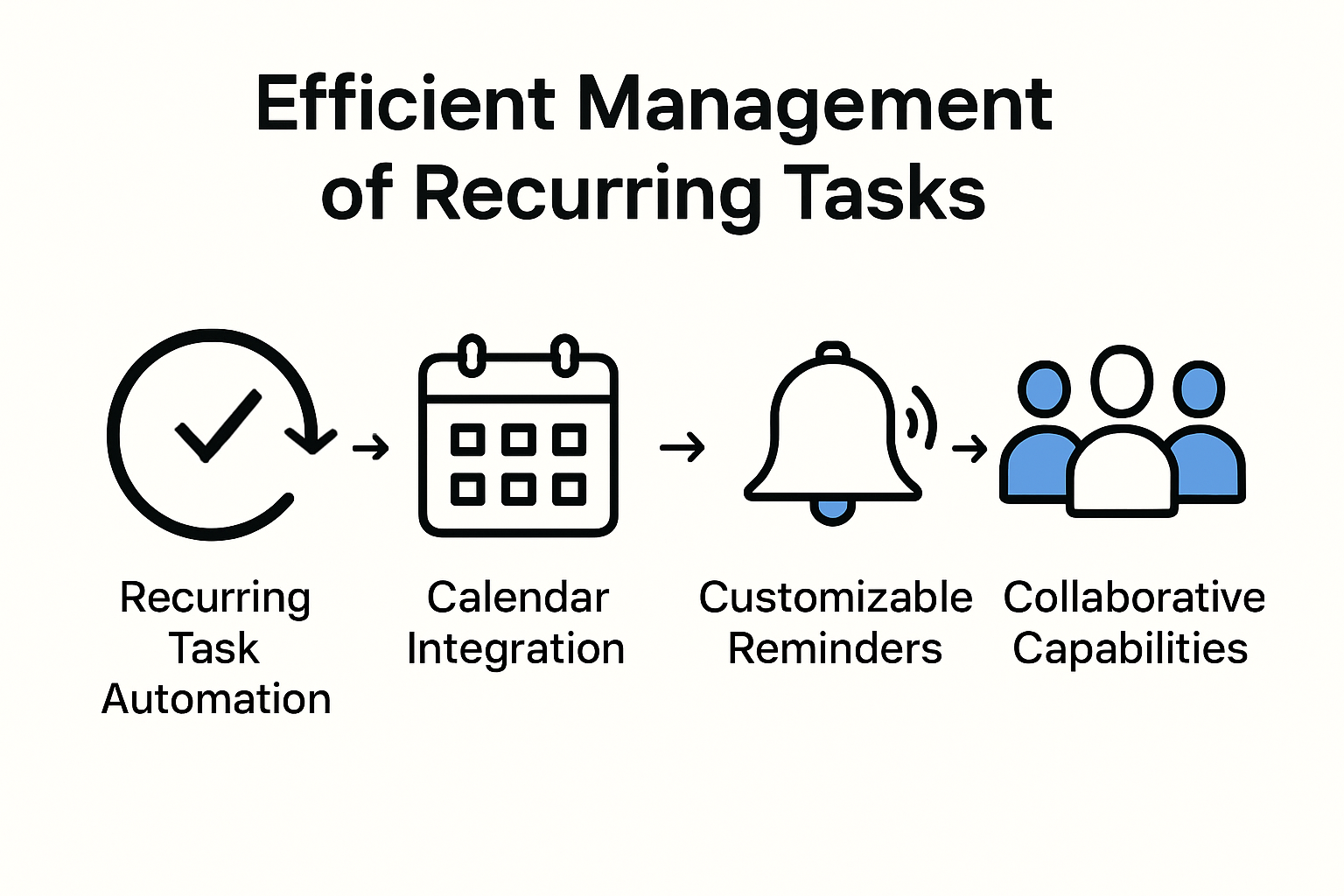Recurring tasks shape the flow of every workplace and set the tempo for teams everywhere. The average employee spends over one-third of their week on repetitive activities, yet most people never realize just how much time slips away on autopilot. Here’s the shocker. Streamlining these routine responsibilities can actually free up hours you never knew you had and open the door to true peak productivity.
Table of Contents
- Understanding Recurring Tasks In The Workplace
- Choosing The Right Tools For Managing Recurring Tasks
- Time-Saving Best Practices For Busy Professionals
- Tracking Progress And Improving Task Management
Quick Summary
| Takeaway | Explanation |
|---|---|
| Prioritize tasks based on impact | Use frameworks like the Eisenhower Matrix to categorize tasks by urgency and importance for better focus. |
| Select tools that fit your workflow | Choose task management tools that automate, integrate, and enhance your personal efficiency to streamline processes. |
| Implement techniques like timeblocking | Timeblocking divides your day into focused segments, promoting concentration and reducing distractions effectively. |
| Conduct regular self-assessments | Regularly evaluate your task management methods to identify inefficiencies and ensure continuous improvement in productivity. |
| Utilize advanced progress tracking methods | Tools like the Activity River help visualize work patterns, revealing insights for optimizing time management effectively. |
Understanding Recurring Tasks in the Workplace
Recurring tasks are the backbone of workplace productivity, representing systematic activities that organizations repeat at regular intervals. These predictable work elements encompass everything from weekly team meetings and monthly financial reports to daily email communications and quarterly performance reviews.
The Nature of Repetitive Work Activities
Workplace recurring tasks are more than just routine responsibilities. According to research from the University of Florida, they represent critical mechanisms for maintaining organizational consistency and operational efficiency. These tasks create a structured framework that allows teams to manage predictable work demands while establishing reliable workflows.
The Centers for Disease Control and Prevention highlights the psychological importance of job crafting within recurring task management. Employees who strategically modify their repetitive tasks can enhance personal engagement and productivity. This approach transforms mundane activities into opportunities for professional growth and skill development.
Strategies for Effective Recurring Task Management
Managing recurring tasks requires a strategic approach that balances consistency with flexibility. The University of Pennsylvania suggests implementing techniques like the Pomodoro method to maintain focus and prevent burnout during repetitive work cycles.
Key strategies for managing recurring tasks include:
- Prioritization: Ranking tasks based on organizational impact and individual workload
- Systematic Tracking: Using digital tools to monitor task completion and performance
- Periodic Review: Regularly evaluating the necessity and efficiency of repeated activities
By understanding the intricate role of recurring tasks, professionals can transform these routine responsibilities into powerful productivity tools. Learn more about optimizing task management for enhanced workplace performance in 2025 and beyond.
Choosing the Right Tools for Managing Recurring Tasks
Selecting the appropriate tools for managing recurring tasks can significantly impact workplace productivity and efficiency. Modern professionals require digital solutions that not only track tasks but also adapt to complex work environments and individual workflow preferences.
Understanding Tool Selection Criteria
According to research from the ACM Digital Library, knowledge workers typically rely on multiple tools simultaneously for task tracking. This complexity underscores the importance of selecting tools that can integrate seamlessly with existing workflows and support diverse task management strategies.
Stanford University’s workshop emphasizes that effective task management tools should address three critical dimensions: functionality, user experience, and personal energy management. Tools must offer features that align with individual work styles while providing robust capabilities for tracking, scheduling, and automating recurring tasks.
Key Features of Effective Task Management Tools
When evaluating task management solutions, professionals should consider the following essential features:
- Recurring Task Automation: Ability to set up and automatically generate repetitive tasks without manual intervention
- Calendar Integration: Seamless synchronization with existing calendar systems to prevent scheduling conflicts
- Customizable Reminders: Flexible alert systems that can be tailored to individual work patterns and preferences
- Collaborative Capabilities: Options for team sharing, task assignment, and progress tracking
Below is a table summarizing the key features to look for when choosing an effective task management tool, along with their benefits:
| Feature | Benefit |
|---|---|
| Recurring Task Automation | Reduces manual work and ensures tasks repeat as needed |
| Calendar Integration | Prevents scheduling conflicts and centralizes planning |
| Customizable Reminders | Increases timely completion with alerts tailored to personal workflows |
| Collaborative Capabilities | Enhances teamwork, allows task sharing, delegation, and group progress tracking |
Explore advanced task management strategies that can transform your workflow and boost overall productivity. By carefully selecting tools that match organizational needs and individual work styles, professionals can create more efficient and responsive task management systems.
The right tool should feel like an extension of your work process, reducing administrative burden while providing clear visibility into ongoing and upcoming tasks. As work environments continue to evolve, selecting adaptable and intelligent task management solutions becomes increasingly critical for maintaining competitive performance.

Time-Saving Best Practices for Busy Professionals
Busy professionals constantly seek methods to maximize productivity and minimize time wastage. Effective time management is not about working harder but working smarter by implementing strategic approaches that optimize workflow and personal energy.
Prioritization and Strategic Planning
edX research highlights the critical importance of using frameworks like the Eisenhower Matrix for task prioritization. This approach helps professionals categorize tasks based on urgency and importance, enabling more intelligent decision-making. By distinguishing between truly critical activities and those that can be delegated or eliminated, individuals can focus their energy on high-impact work.
According to the University of Georgia Extension, tracking time in granular increments—specifically 15-minute segments—can reveal unexpected insights into personal productivity patterns. This method allows professionals to identify time-consuming activities and restructure their workflows more efficiently.
Below is a table comparing popular time management techniques mentioned in this section, highlighting their purpose and main benefits:
| Technique | Purpose | Main Benefit |
|---|---|---|
| Eisenhower Matrix | Categorize tasks by urgency and importance | Helps focus on high-impact work |
| 15-Minute Increment Tracking | Monitor time usage in precise, short intervals | Identifies time-draining activities and patterns |
| Timeblocking | Allocate specific segments for dedicated tasks | Increases focus and reduces distractions |
| Pomodoro Technique | Work in short bursts with planned breaks | Maintains concentration and prevents burnout |
| SMART Goal Setting | Set clear, actionable objectives | Provides direction and increases achievement rates |
Advanced Time Management Techniques
Modern professionals can leverage several sophisticated techniques to enhance productivity:
-
Timeblocking: As described in Wikipedia’s entry on timeblocking, this technique involves dividing time into specific segments dedicated to particular tasks. By creating artificial urgency and promoting single-tasking, professionals can dramatically reduce distractions and increase focus.
-
SMART Goal Setting: Establishing Specific, Measurable, Achievable, Relevant, and Time-bound objectives provides a structured approach to task management.
-
Pomodoro Technique: Working in focused 25-minute intervals followed by short breaks can help maintain high concentration levels and prevent burnout.
Discover advanced productivity strategies that can transform your professional performance. By implementing these targeted time-saving practices, busy professionals can create more meaningful work experiences, reduce stress, and achieve higher levels of personal and organizational effectiveness.
Ultimately, successful time management is about creating systems that align with individual work styles, leveraging technology, and maintaining a disciplined yet flexible approach to task completion. The most productive professionals are those who continuously refine their strategies and remain adaptable in an ever-changing work environment.
Tracking Progress and Improving Task Management
Effective task management goes beyond mere completion. It involves systematic tracking, continuous improvement, and strategic reflection on work processes. Professionals who master progress tracking can transform their productivity and achieve more meaningful outcomes.
Advanced Progress Monitoring Techniques
Research from edX reveals that successful task management requires more than traditional tracking methods. Modern professionals need dynamic systems that provide real-time insights into workflow efficiency, task completion rates, and potential bottlenecks.
The innovative ‘Activity River’ visualization tool represents a breakthrough in progress tracking. This approach enables individuals to not just log activities but also reflect on their work patterns, helping them identify areas for optimization and personal growth. By creating a visual representation of time usage, professionals can gain unprecedented insights into their productivity cycles.
Strategic Improvement Frameworks
Improving task management is an iterative process that demands regular assessment and adaptation. Key strategies for continuous improvement include:
- Performance Metrics: Establishing clear, measurable indicators of task completion and efficiency
- Periodic Review: Conducting regular self-assessments to understand work patterns and identify improvement opportunities
- Feedback Integration: Incorporating insights from team members and supervisors to refine task management approaches
The following table summarizes these strategic frameworks for improving recurring task management, outlining their purpose and role in continuous improvement:
| Strategy/Framework | Purpose | Contribution to Improvement |
|---|---|---|
| Performance Metrics | Measure efficiency and track completion | Highlights strengths and gaps |
| Periodic Review | Regular evaluation of work patterns | Identifies improvement opportunities |
| Feedback Integration | Gather input from teams/supervisors | Refines approaches and fosters alignment |
| Growth Mindset | Embrace adaptation and continuous learning | Drives ongoing professional development |
Explore comprehensive progress tracking methods that can revolutionize your professional workflow. By adopting a proactive approach to task management, professionals can create more resilient, adaptable work systems that evolve with changing organizational needs.
Ultimately, effective progress tracking is about developing a growth mindset. It requires curiosity, openness to change, and a commitment to continuous learning. The most successful professionals view task management not as a static process, but as a dynamic journey of personal and professional development.

Frequently Asked Questions
What are recurring tasks in the workplace?
Recurring tasks are systematic activities that organizations repeat at regular intervals, such as weekly meetings or monthly reports. They help maintain operational efficiency and consistency.
How can I effectively manage recurring tasks?
To manage recurring tasks effectively, prioritize them based on impact, systematically track progress, and conduct periodic reviews to assess their efficiency and necessity.
What tools should I use for managing recurring tasks?
Choose task management tools that offer features like recurring task automation, calendar integration, customizable reminders, and collaborative capabilities to enhance workflow efficiency.
What are some best practices for time management related to recurring tasks?
Implement techniques like the Eisenhower Matrix for prioritization, time blocking for focused work sessions, and regular self-assessments to identify inefficiencies and optimize productivity.
Unlock Control Over Recurring Work With Gammatica
If you find yourself overwhelmed by repetitive tasks, complex team calendars, or scattered checklists, you’re not alone. The article calls out a real and pressing challenge: routine work drains time and energy every week. Managing recurring activities and staying organized are key pain points for ambitious teams and leaders—efficiency is the secret up-and-coming companies want to master.

Take the pressure off your schedule now. Gammatica is built to automate and streamline everything from daily task cycles to full project lifecycles. Use powerful AI features and ready-made templates to reclaim your time, not just track it. Don’t wait for burnout or confusion to set in. Start transforming your productivity today by discovering the full range of Gammatica’s AI-driven management tools. For a deep dive into practical strategies, check out our guide on how to manage tasks effectively and set your team up for stress-free, consistent success.
Recommended
- How to Manage Tasks Effectively in 2025: Proven Strategies for Leaders | Gammatica
- Project Progress Tracking: Strategies for Success in 2025 | Gammatica
- Automation for Small Businesses: Essential Strategies for 2025 | Gammatica
- Collaborative Decision Making for Leaders: Strategies for 2025 | Gammatica



